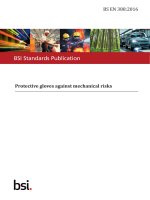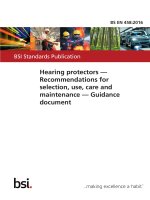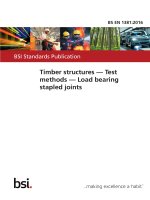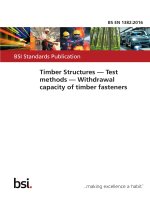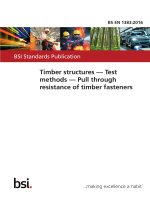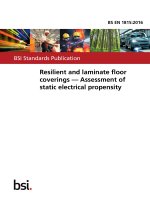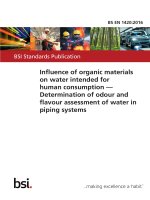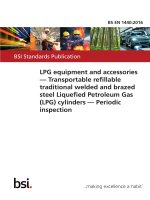Bsi bs en 13618 2016
Bạn đang xem bản rút gọn của tài liệu. Xem và tải ngay bản đầy đủ của tài liệu tại đây (2.02 MB, 34 trang )
BS EN 13618:2016
BSI Standards Publication
Flexible hose assemblies in
drinking water installations —
Functional requirements and
test methods
BS EN 13618:2016
BRITISH STANDARD
National foreword
This British Standard is the UK implementation of EN 13618:2016. It
supersedes BS EN 13618:2011 which is withdrawn.
The UK participation in its preparation was entrusted to Technical
Committee B/504, Water supply.
A list of organizations represented on this committee can be
obtained on request to its secretary.
This publication does not purport to include all the necessary
provisions of a contract. Users are responsible for its correct
application.
© The British Standards Institution 2016.
Published by BSI Standards Limited 2016
ISBN 978 0 580 93160 4
ICS 23.040.70; 91.140.60
Compliance with a British Standard cannot confer immunity from
legal obligations.
This British Standard was published under the authority of the
Standards Policy and Strategy Committee on 31 December 2016.
Amendments/Corrigenda issued since publication
Date
Text affected
BS EN 13618:2016
EN 13618
EUROPEAN STANDARD
NORME EUROPÉENNE
EUROPÄISCHE NORM
December 2016
ICS 23.040.70; 91.140.60
Supersedes EN 13618:2011
English Version
Flexible hose assemblies in drinking water installations Functional requirements and test methods
Tuyaux flexibles pour installations d'eau potable Exigences fonctionnelles et méthodes d'essai
Flexible Schlauchverbindungen in TrinkwasserInstallationen - Funktionsanforderungen und
Prüfverfahren
This European Standard was approved by CEN on 15 August 2016.
CEN members are bound to comply with the CEN/CENELEC Internal Regulations which stipulate the conditions for giving this
European Standard the status of a national standard without any alteration. Up-to-date lists and bibliographical references
concerning such national standards may be obtained on application to the CEN-CENELEC Management Centre or to any CEN
member.
This European Standard exists in three official versions (English, French, German). A version in any other language made by
translation under the responsibility of a CEN member into its own language and notified to the CEN-CENELEC Management
Centre has the same status as the official versions.
CEN members are the national standards bodies of Austria, Belgium, Bulgaria, Croatia, Cyprus, Czech Republic, Denmark, Estonia,
Finland, Former Yugoslav Republic of Macedonia, France, Germany, Greece, Hungary, Iceland, Ireland, Italy, Latvia, Lithuania,
Luxembourg, Malta, Netherlands, Norway, Poland, Portugal, Romania, Slovakia, Slovenia, Spain, Sweden, Switzerland, Turkey and
United Kingdom.
EUROPEAN COMMITTEE FOR STANDARDIZATION
COMITÉ EUROPÉEN DE NORMALISATION
EUROPÄISCHES KOMITEE FÜR NORMUNG
CEN-CENELEC Management Centre: Avenue Marnix 17, B-1000 Brussels
© 2016 CEN
All rights of exploitation in any form and by any means reserved
worldwide for CEN national Members.
Ref. No. EN 13618:2016 E
BS EN 13618:2016
EN 13618:2016 (E)
Contents
Page
European foreword....................................................................................................................................................... 4
1
Scope .................................................................................................................................................................... 5
2
Normative references .................................................................................................................................... 5
3
Terms and definitions ................................................................................................................................... 6
4
4.1
4.1.1
4.1.2
4.1.3
4.1.4
4.1.5
4.1.6
4.2
4.2.1
4.2.2
4.2.3
Requirements ................................................................................................................................................... 8
Materials............................................................................................................................................................. 8
General ................................................................................................................................................................ 8
Chemical and hygienic requirements ...................................................................................................... 8
Hoses .................................................................................................................................................................... 8
Fittings and sleeves ........................................................................................................................................ 8
Braiding .............................................................................................................................................................. 8
Sealings ............................................................................................................................................................... 8
Functional requirements.............................................................................................................................. 8
General ................................................................................................................................................................ 8
Fittings ................................................................................................................................................................ 9
Hose assemblies............................................................................................................................................ 12
5
Designation..................................................................................................................................................... 15
6
Marking ............................................................................................................................................................ 15
Annex A (normative) Tests on fittings ............................................................................................................... 17
A.1
Dimensions and thread control .............................................................................................................. 17
A.2
Ammonium test............................................................................................................................................. 17
A.3
Tightening test .............................................................................................................................................. 17
A.3.1 Test samples .................................................................................................................................................. 17
A.3.2 Procedure........................................................................................................................................................ 17
A.4
Bending test ................................................................................................................................................... 18
A.4.1 Test samples .................................................................................................................................................. 18
A.4.2 Procedure........................................................................................................................................................ 18
Annex B (normative) Hose assembly tests ....................................................................................................... 21
B.1
Flow rate test ................................................................................................................................................. 21
B.1.1 Test samples .................................................................................................................................................. 21
B.1.2 Procedure........................................................................................................................................................ 21
B.2
Ageing treatment by hot storage ............................................................................................................ 22
B.2.1 Test samples .................................................................................................................................................. 22
B.2.2 Procedure........................................................................................................................................................ 22
B.3
Tensile test ..................................................................................................................................................... 22
B.3.1 Test samples .................................................................................................................................................. 22
B.3.2 Procedure........................................................................................................................................................ 22
B.4
Hydrostatic pressure test .......................................................................................................................... 22
B.4.1 Test samples .................................................................................................................................................. 22
B.4.2 Procedure........................................................................................................................................................ 22
B.5
Hydraulic performance and durability test........................................................................................ 23
B.5.1 Test samples .................................................................................................................................................. 23
B.5.2 Test conditions .............................................................................................................................................. 23
B.5.3 Procedure........................................................................................................................................................ 23
2
BS EN 13618:2016
EN 13618:2016 (E)
B.6
B.6.1
B.6.2
B.6.3
B.7
B.7.1
B.7.2
B.8
B.8.1
B.8.2
B.9
B.9.1
B.9.2
B.10
B.10.1
B.10.2
Test of resistance to pressure jumps ..................................................................................................... 24
Test samples ................................................................................................................................................... 24
Test conditions .............................................................................................................................................. 24
Procedure ........................................................................................................................................................ 24
Temperature cycling test ........................................................................................................................... 24
Test samples ................................................................................................................................................... 24
Procedure ........................................................................................................................................................ 25
Corrosion resistance test ........................................................................................................................... 25
Test samples ................................................................................................................................................... 25
Procedure ........................................................................................................................................................ 25
Bending test .................................................................................................................................................... 25
Test samples ................................................................................................................................................... 25
Procedure ........................................................................................................................................................ 25
Test of resistance to frost .......................................................................................................................... 27
Test samples ................................................................................................................................................... 27
Procedure ........................................................................................................................................................ 27
Annex C (informative) Surveillance testing ..................................................................................................... 28
Bibliography ................................................................................................................................................................. 29
3
BS EN 13618:2016
EN 13618:2016 (E)
European foreword
This document (EN 13618:2016) has been prepared by Technical Committee CEN/TC 164 “Water
supply”, the secretariat of which is held by AFNOR.
This European Standard shall be given the status of a national standard, either by publication of an
identical text or by endorsement, at the latest by June 2017, and conflicting national standards shall be
withdrawn at the latest by June 2017.
Attention is drawn to the possibility that some of the elements of this document may be the subject of
patent rights. CEN [and/or CENELEC] shall not be held responsible for identifying any or all such patent
rights.
This document supersedes EN 13618:2011.
EN 13618:2016 includes the following significant technical changes with respect to EN 13618:2011:
a) the stress corrosion testing is carried out with ammonium only;
b) requirement ad test method for resistance of seat of female fitting are deleted;
c) in Table 8, specific minimum flow rates and minimum bore diameters are left open;
d) for testing the pressure jumps resistance, detailed specification for DN and applied test pressure
are given;
e) new test methods for corrosion resistance and UV resistance are introduced;
f)
in Table A.2, the dimensions C are reduced;
g) in hydraulic performance and durability test, the number of impulses is reduced;
h) the recommended surveillance testing of specific functional requirements is introduced.
According to the CEN/CENELEC Internal Regulations, the national standards organizations of the
following countries are bound to implement this European Standard: Austria, Belgium, Bulgaria,
Croatia, Cyprus, Czech Republic, Denmark, Estonia, Finland, Former Yugoslav Republic of Macedonia,
France, Germany, Greece, Hungary, Iceland, Ireland, Italy, Latvia, Lithuania, Luxembourg, Malta,
Netherlands, Norway, Poland, Portugal, Romania, Slovakia, Slovenia, Spain, Sweden, Switzerland,
Turkey and the United Kingdom.
4
BS EN 13618:2016
EN 13618:2016 (E)
1 Scope
This European Standard specifies the requirements and test methods for materials, dimensions and
function for flexible hose assemblies for drinking water installations, braided or not, designed for use
with drinking water with an allowable maximum operating pressure (PMA) of 1 MPa and maximum
operating temperature 70 °C to connect sanitary tap ware, heaters and similar appliances.
NOTE
Flexible hose assemblies intended to be used as integral parts of electrical appliances are covered by
EN 61770 [1].
2 Normative references
The following documents, in whole or in part, are normatively referenced in this document and are
indispensable for its application. For dated references, only the edition cited applies. For undated
references, the latest edition of the referenced document (including any amendments) applies.
EN 248, Sanitary tapware — General specification for electrodeposited coatings of Ni-Cr
EN 806-2, Specification for installations inside buildings conveying water for human consumption — Part
2: Design
EN 1254-2, Copper and copper alloys — Plumbing fittings — Part 2: Fittings with compression ends for
use with copper tubes
EN 1254-3, Copper and copper alloys — Plumbing fittings — Part 3: Fittings with compression ends for
use with plastics pipes
EN 1254-4, Copper and copper alloys — Plumbing fittings — Part 4: Fittings combining other end
connections with capillary or compression ends
EN ISO 228-1, Pipe threads where pressure-tight joints are not made on the threads — Part 1: Dimensions,
tolerances and designation (ISO 228-1)
EN ISO 1456, Metallic and other inorganic coatings — Electrodeposited coatings of nickel, nickel plus
chromium, copper plus nickel and of copper plus nickel plus chromium (ISO 1456)
EN ISO 9080, Plastics piping and ducting systems — Determination of the long-term hydrostatic strength
of thermoplastics materials in pipe form by extrapolation (ISO 9080)
EN ISO 15875-2, Plastics piping systems for hot and cold water installations — Crosslinked polyethylene
(PE-X) — Part 2: Pipes (ISO 15875-2)
EN ISO 15876-2, Plastics piping systems for hot and cold water installations — Polybutylene (PB) — Part
2: Pipes (ISO 15876-2)
EN ISO 22391-2, Plastics piping systems for hot and cold water installations — Polyethylene of raised
temperature resistance (PE-RT) — Part 2: Pipes (ISO 22391-2)
EN ISO 30013:2011, Rubber and plastics hoses — Methods of exposure to laboratory light sources —
Determination of changes in colour, appearance and other physical properties (ISO 30013:2011)
ISO 7-1, Pipe threads where pressure-tight joints are made on the threads — Part 1: Dimensions,
tolerances and designation
ISO 6957, Copper alloys — Ammonia test for stress corrosion resistance
5
BS EN 13618:2016
EN 13618:2016 (E)
3 Terms and definitions
For the purposes of this document, the following terms and definitions apply.
3.1
hose assembly
flexible hose with or without braiding and furnished at one or both ends with a fitting or an integrated
flange, or adapted to meet the use of appropriate fittings
Note 1 to entry:
See Figure 1:
Key
1 internal hose
2 braiding
3 sleeve
4 fitting
5 outer layer (optional)
Figure 1 — Example of hose assembly components
3.2
internal hose
internal part of the hose assembly
3.3
braiding
external applied reinforcement intended to achieve the pressure resistance and to protect the internal
hose from blunt impact, rubbing or constriction, usually achieved with stainless steel or synthetic wires
3.4
sleeve
component used to fix internal hose mechanically to fittings
3.5
fitting
component attached to the end of the flexible hose to facilitate connection to appliances
Note 1 to entry:
6
Examples of shape and designation of the fitting are given in Table 1:
BS EN 13618:2016
EN 13618:2016 (E)
Table 1 — Shape and designation of fittings
Type
Shape
Fixed male
fitting
in
accordance
with
EN ISO 228-1
or ISO 7-1
1
Revolving
male fitting
in
accordance
with
EN ISO 228-1
or ISO 7-1
2
Straight
female fitting
in
accordance
with
EN ISO 228-1
or ISO 7-1
3
Elbow
female fitting
in
accordance
with
EN ISO 228-1
4
Compression
biconical
fitting
5
Fitting with
plain
and
short smooth
tube
with
recess
6
Fitting with
plain
and
short smooth
tube without
recess
7
8
9
Designation
—
Metric male
thread fitting
Special
applications
7
BS EN 13618:2016
EN 13618:2016 (E)
4 Requirements
4.1 Materials
4.1.1 General
All materials used shall be chemically compatible with each other and with the water supplied
(following the common chemical reaction and/or corrosion knowledge of the materials concerned).
4.1.2 Chemical and hygienic requirements
All materials coming into contact with water intended for human consumption shall not present a
health risk or cause any change in the drinking water in terms of quality, appearance, smell or taste.
Products intended for use in drinking water supply systems should comply with national regulations
and testing arrangements, where they exist, that ensure fitness for contact with drinking water.
4.1.3 Hoses
4.1.3.1 Internal hoses
Internal hoses can be made of elastomeric, thermoplastics and plastics materials.
4.1.3.2 Non-braided hoses
Non-braided hoses shall comply with long-term stress requirements in accordance with
EN ISO 15875-2, EN ISO 15876-2 and EN ISO 22391-2 when evaluated in accordance with EN ISO 9080.
4.1.4 Fittings and sleeves
Fittings and sleeves with exception of plain end fittings with and without recess shall be manufactured
from corrosion-resistant materials.
Sleeves and plain end fittings with and without recess shall be made of corrosion-resistant metallic
materials only.
Aluminium materials are not allowed.
4.1.5 Braiding
Braiding shall be made of stainless steel wires or plastics wires/bands.
Braiding made of stainless steel can have integrated plastic wires/bands for colour coding only.
In case of braiding made of plastics materials, the hose assembly shall be UV resistant in accordance
with 4.2.3.10.
4.1.6 Sealings
Sealing materials shall demonstrate the compliance with 4.2.
4.2 Functional requirements
4.2.1 General
The separate components and hose assemblies shall comply and be tested to the functional
requirements as indicated in Table 2.
The surveillance testing for specific functional requirements is recommended. If the surveillance testing
is carried out, this should be done in accordance with Annex C.
8
BS EN 13618:2016
EN 13618:2016 (E)
Table 2 — List of characteristics for separate components and for hose assemblies
Requirement
subclause
Characteristic
Test method
clause/subclause
Fittings and sleeves
Dimensions
4.2.2.1
A.1
Resistance to tightening torque of fitting
4.2.2.3
A.3
Stress corrosion
Resistance to bending
Hose assembly
4.2.2.2
4.2.2.4
A.2
A.4
Length of hose assembly
4.2.3.1
4.2.3.1
Tensile stress resistance
4.2.3.4
B.3
Flow rate
Leak
pressure
tightness
under
Pressure cycling resistance
4.2.3.2
internal
Resistance to pressure jumps
Temperature cycling resistance
Frost resistance
Resistance to corrosion
Flexibility
UV resistance
4.2.2 Fittings
hydrostatic
4.2.3.3
4.2.3.5
4.2.3.6
4.2.3.7
B.1
B.4
B.5
B.6
B.7
4.2.3.8
B.10
4.2.3.11
B.9
4.2.3.9
4.2.3.10
B.8
4.2.3.10
4.2.2.1 Dimensions
Fittings shall comply with the appropriate dimensions as stated in Tables 3, 4 and 5 when checked in
accordance with A.1, and with the relevant functional requirements as stated in EN 1254-2, EN 1254-3
and EN 1254-4.
Fittings with push-fit ends and with press end for metallic tubes shall comply with requirements of this
standard.
9
BS EN 13618:2016
EN 13618:2016 (E)
Table 3 — Fixed fittings with external thread
Threading th in accordance with
Minimum useful
threading length l
in accordance
with EN ISO 228-1
mm
mm
8,8
7
ISO 7-1
EN ISO 228-1
R 1/4
G 1/4 B
R 1/2
G 1/2 B
11,4
G1B
14,5
R 3/8
G 3/8 B
R 3/4
G 3/4 B
R1
R 5/4
G 5/4 B
8,4
6
7
12,7
8,5
16,8
11
9,5
Table 4 — Female fittings with nut
Threading th
in accordance with EN ISO 228-1
G 1/4
G 3/8
G 1/2
G 3/4
G1
G 1 1/4
10
Gauge length in
accordance with
ISO 7-1
Minimum useful threading length l
mm
4
5
6
7
8
10
BS EN 13618:2016
EN 13618:2016 (E)
Table 5 — Plain end fittings with and without recess
External diameter
mm
d1
d2
8 ± 0,1
7,7 +−0,05
0,1
12 ± 0,1
11,7 +−0,05
0,1
10 ± 0,1
15 ± 0,1
22 ± 0,1
Minimum length l
mm
l1
9,7 +−0,05
0,1
14,7 +−0,05
0,1
mm
25
5
11
7
25
10
4.2.2.2 Stress corrosion
l3
25
10
21,7 +−0,05
0,1
l2
7
7
Wrench
size E
30
30
5
7
7
—
10
Inner
diameter
h
mm
Wall
thickness t
mm
≤8
≥ 0,8
≤ 6,3
13
≤ 10
—
≤ 19
17
≤ 13
≥ 0,75
≥ 0,9
≥ 1,4
≥ 1,5
Brass fittings, including sleeves, shall be free from internal tensional stresses and shall resist the
ammonium test described in A.2.
Fittings shall show no evidence of cracking visible when 10-times magnified.
4.2.2.3 Resistance to tightening torque
When tested in accordance with A.3, male fittings and swivel nuts shall resist a tightening torque as
specified in Table 6 without evidence of cracks visible when 10-times magnified.
Table 6 — Tightening torque for male fittings and nuts
Threading
ISO 7-1
EN ISO 228-1
R 1/4
G 1/4
R 1/2
G 1/2
R 3/8
R 3/4
R1
R 5/4
G 3/8
Tightening torque
Nm
30 ± 1
40 ± 2
80 ± 2
G 3/4
100 ± 4
G 5/4
150 ± 8
G1
120 ± 6
11
BS EN 13618:2016
EN 13618:2016 (E)
4.2.2.4 Resistance to bending
When tested in accordance with A.4, fittings shall resist the minimum bending torques as specified in
Table 7 without evidence of cracks visible when 10-times magnified.
Table 7 — Minimum bending torque for shanks
Nominal diameter
DN 6
7,5 +1
0
DN 10
15 +1
0
Minimum bending torque
Nm
10 +1
0
DN 8
20 +1
0
DN 13
30 +1
0
DN 15
35 +1
0
DN 18
40 +1
0
DN 20
45 +1
0
DN 25
4.2.2.5 Special cases
Fittings for hose assemblies intended for special applications, e.g. for direct installation to appliances
where dimensional compatibility is not a requirement (for example, direct to a sanitary tap with metric
threading in accordance with ISO 68-1 (see [2])), may incorporate dimensional deviations, provided
that:
— all requirements of 4.2.3, with the exception of flow rate, are satisfied;
— the manufacturer’s literature, including installation instructions supplied with the hose assembly,
indicates clearly that it is a special case.
4.2.3 Hose assemblies
4.2.3.1 Length
All hose assemblies shall be manufactured in lengths L measured as shown in Figure 2 from a minimum
of 90 mm to a maximum of 2 000 mm.
The actual length compared with the length L declared by the supplier shall be within the following
permissible tolerances:
—
—
—
12
L ≤ 400 mm
:
+10
0
1 000 mm < L ≤ 2 000
:
+30
0
400 mm < L ≤ 1 000 mm
:
+20
0
BS EN 13618:2016
EN 13618:2016 (E)
Figure 2 — Reference dimensions for hose length
4.2.3.2 Flow rate
The flow rate of hose assemblies shall comply with the values as indicated in Table 8.
The hose assemblies are considered to comply with this requirement, when the measured flow rate,
when tested in accordance with B.1, is in compliance with Table 8 (for DN 6 to DN 13) or when the
minimum diameter of bore is met (for DN 15 to DN 25).
Table 8 — Dimensions of fitting holes and minimum flow rates
Nominal size
DN 6
DN 8
DN 10
DN 13
DN 15
DN 18
DN 20
DN 25
Minimum flow rate
l/min
Minimum diameter of bore
mm
28
—
16
45
60
—
—
—
—
12,5
—
17
—
—
4.2.3.3 Leak tightness under internal hydrostatic pressure
15
20
When tested in accordance with B.4 to an internal water pressure of 3,0 MPa, the hose assemblies shall
not show signs of any leakage.
4.2.3.4 Tensile stress resistance
When tested in accordance with B.3, hose assemblies shall be resistant to a tensile stress as given in
Table 9. During and after this test, the hose assembly shall show no leakage or other damage.
13
BS EN 13618:2016
EN 13618:2016 (E)
Table 9 — Tensile stress values
Nominal size
DN 6
DN 8
DN 10
Tensile stress
N
600
600
800
DN 13
1 100
DN 18
2 100
DN 15
DN 20
DN 25
4.2.3.5 Pressure cycling resistance
1 500
2 500
3 400
When tested in accordance with B.5, hose assemblies shall withstand a pressure cycling in the range
from 0,5 MPa to 3,0 MPa.
4.2.3.6 Resistance to pressure jumps
When tested in accordance with B.6 for nominal size up to DN 15 at a pressure of 0,5 MPa and for
nominal size greater than DN 15 at a pressure of 3,0 MPa, hose assemblies shall resist to pressure jump
for 200 impulses.
4.2.3.7 Resistance to temperature cycling
When tested in accordance with B.7 after 5 000 cycles, hose assemblies shall not show any sign of
damage and leakage.
4.2.3.8 Frost resistance
When tested in accordance with B.10, hose assemblies shall not show any sign of damage and leakage.
4.2.3.9 Resistance to corrosion
When tested in accordance with B.8, hose assemblies shall not show any corrosion defect when
inspected in accordance with method described in EN ISO 1456.
4.2.3.10 UV resistance
When exposed to UV radiation in accordance with EN ISO 30013:2011, Method B, cycle 3, with an
energy dose of 25 MW/m2, the hose assembly with plastics braiding shall comply with the resistance to
pressure jumps in accordance with 4.2.3.6.
4.2.3.11 Flexibility
When tested in accordance with B.9 under the conditions as given in Table 10, the ovality to be
measured shall not exceed 15 %.
14
BS EN 13618:2016
EN 13618:2016 (E)
Table 10 — Bending radius, length of specimen and tensile force
Nominal
size
Internal radius
DN 6
R
mm
General
For plastics hoses without
braiding
30
400 to 450
400 to 450
15
500 to 550
15
45
20
200
35
500
25
DN 8
DN 10
35
DN 13
45
DN 15
60
DN 18
70
DN 20
80
DN 25
5 Designation
Tensile force for hose assemblies
N
Length of test
specimen
L
mm
100
600 to 660
700 to 770
800 to 880
900 to 1 000
1 100 to 1 200
30
55
300
45
Not applicable
65
Not applicable
50
Not applicable
Flexible hose assemblies complying with this European Standard shall be designated with at least the
following:
a) name of the product (e.g. flexible hose assembly);
b) reference to this standard (EN 13618);
c) nominal pressure of 10 bar (PN);
d) design temperature 70 °C in accordance with EN 806-2, in °C;
e) nominal diameter (DN);
f)
length L, in mm (see 4.2.3.1);
g) type of fitting (see Table 1).
EXAMPLE
Hose assembly, for PN of 10 bar maximum operating temperature 70 °C, nominal diameter 10 mm,
length 300 mm, equipped at the ends with fittings of type 1 and type 2 in accordance with Table 1.
NOTE
Hose assembly EN 13618 — PN 10 — 70 °C — DN 10 — L 300 — fitting types 1 and 2
10 bar = 1,0 MPa.
6 Marking
Products complying with this European Standard shall be marked permanently and legibly with at least
the following information:
— name or trademark of the manufacturer or supplier;
— at least the last two digits of the production year;
15
BS EN 13618:2016
EN 13618:2016 (E)
— maximum operating temperature 70 °C.
Internal hoses shall be marked with the name or trademark of the manufacturer or supplier and date of
production.
16
BS EN 13618:2016
EN 13618:2016 (E)
Annex A
(normative)
Tests on fittings
A.1 Dimensions and thread control
The control of the dimensions shall be carried out by using appropriate gauges graduated in millimetre
or subdivisions thereof, for the values indicated in 4.2.2.1. The thread measurement shall be carried out
by go-not-go gauges. The test results shall be compared with 4.2.2.1.
A.2 Ammonium test
The ammonium test shall be carried out in accordance with ISO 6957 at pH ≤ 9. The results to be
obtained are indicated in 4.2.2.2.
A.3 Tightening test
A.3.1 Test samples
Ten samples shall be taken for each type in accordance with Table 1.
A.3.2 Procedure
A.3.2.1 Male fittings
a) Screw the fitting, without any sealing washer, into the steel nut as described in Table A.1.
b) Gradually apply the tightening torque as stated in Table 6.
c) Release the fitting.
d) Examine the fitting for evidence of failures or cracks visible when 10-times magnified.
Table A.1 — Test cap dimensions
Dimensions in millimetres
T
EN ISO 228-1
G1/4
G3/8
G1/2
G3/4
ISO 7-1
R1/4
R3/8
R1/2
R3/4
L
The length L of the steel nut shall be three quarters of
the threading length of the male fitting.
17
BS EN 13618:2016
EN 13618:2016 (E)
A.3.2.2 Swivel nuts
a) Screw the swivel nut, without any sealing washer, onto the steel rod as described in Table A.2.
b) Gradually apply a torque as stated in Table 6.
c) Release the nut.
d) Examine the nut for evidence of failures or cracks visible when 10-times magnified.
Table A.2 — Test bolt dimensions
T
EN ISO 228-1
Da
mm
Ca
mm
La
mm
G3/8 B
14,5
2
7
10,5
G3/4 B
23,5
9
14,5
G1/4 B
G1/2 B
a
11
18
All dimensions with tolerance ± 0,1 mm.
2
3
3
7
9
da
mm
8,5
12,5
A.4 Bending test
A.4.1 Test samples
Ten samples shall be taken for each type in accordance with Table 1.
A.4.2 Procedure
A.4.2.1 Male fittings and swivel nuts
a) Screw the fitting, without any sealing washer, to a solid fixture as shown in Figure A.1 in two
examples.
b) Slip over the shank a steel tube having a wall thickness of at least 2 mm and an inner diameter
0,05 mm larger than the outer diameter of the shank itself, as shown in Figure A.1.
18
BS EN 13618:2016
EN 13618:2016 (E)
c) Continuously apply a force to the steel tube to submit the shank to a torque not less than the one
stated in Table 7 within 2 s. The force is maintained for 30 s.
Key
1 female fitting
2 steel pipe
3 male fitting
Figure A.1 — Placing of tube on shank
d) Release the swivel nut.
e) Check the fitting for evidence of cracks visible when 10-times magnified. Distortions without cracks
do not constitute failure.
A.4.2.2 Elbow fittings
a) The coupling tube is firmly attached by its coupling nut, without any sealing washer, to a fixed
mandrel as shown in Figure A.2.
b) A steel tube, having a wall thickness of at least 2 mm and an inner diameter 0,2 mm larger than the
outer diameter of the coupling tube, is slipped over the coupling tube as shown in Figure A.2.
c) A force is applied to the steel tube so that the coupling tube is subjected to a bending moment of
10 Nm which is attained in 2 s. The force is maintained for 30 s.
For angled coupling tubes, two tests are carried out on separate samples. In one test the moment is
applied in the direction of the angle and in the other test it is applied in the opposite direction.
19
BS EN 13618:2016
EN 13618:2016 (E)
Key
1 fixed mandrel
2 coupling nut
3 coupling tube
4 steel tube
Figure A.2 — Detail for applying the bending moment to coupling tubes
20
BS EN 13618:2016
EN 13618:2016 (E)
Annex B
(normative)
Hose assembly tests
B.1 Flow rate test
B.1.1 Test samples
Three samples, each 300 mm long, shall be taken for each DN type.
B.1.2 Procedure
a) Connect the samples in a horizontal position to the supply and test circuits. A pipe or other system
may be used to support the hose assembly during the test (see Figure B.1). The supply and test
circuits shall be capable of delivering a flow rate of at least 1,5-times the flow rate of the hose
assembly under test.
Key
1
2
3
4
5
6
7
8
9
10
means to supply and to maintain a pressure of (0,3 ± 0,02) MPa
pipe
device to measure the flow rate with an accuracy of ± 2 % of the test value
shut-off valve
pressure gauge with an accuracy of ± 1 % of the test value
hose assembly connector
support to maintain the hose assembly in a straight and horizontal position
free outlet
supply circuit
test circuit
Figure B.1 — Test apparatus
b) Apply a pressure of (0,3 ± 0,02) MPa with cold water at temperature of (20 ± 5) °C.
c) Measure the flow rate after stabilization.
d) Record the result and compare with 4.2.3.2, Table 8.
21
BS EN 13618:2016
EN 13618:2016 (E)
B.2 Ageing treatment by hot storage
B.2.1 Test samples
15 samples shall be taken for each DN type.
B.2.2 Procedure
a) Fill the samples with water and apply a pressure of (1,2 ± 0,05) MPa and maintain this pressure
during the entire treatment.
Store the samples for 168 h at a temperature of 90 +−13 °C.
b) Cool down the samples to temperature of (20 ± 5) °C and replace the gaskets, if applicable.
B.3 Tensile test
B.3.1 Test samples
Three samples shall be taken for each DN type and treated for ageing in accordance with B.2.
B.3.2 Procedure
a) The test shall be conducted at ambient temperature of (20 ± 5) °C.
b) Fix the samples to a dynamometer capable of a tensile speed of 3,3 mm/s.
c) Subject the samples to a tensile force as indicated in Table 9, maintain this force for a period of
(60 ± 1) min and check the samples for failures, damage and whether the fittings are loosened from
their seat.
d) Release the samples and fill them with water.
e) Apply a pressure of (1,6 ± 0,1) MPa at a rate of 0,1 MPa/s, maintain this pressure for at least 1 min
and check the samples for failures, damage and leakage and whether the fittings are loosened from
their seat in axial direction.
B.4 Hydrostatic pressure test
B.4.1 Test samples
Three samples shall be taken for each DN type and treated for ageing in accordance with B.2.
B.4.2 Procedure
a) Fill the samples with water at a temperature:
1) of 90 +−13 °C for braided flexible hose assemblies;
2) of 70 +−13 °C for non-braided flexible hose assemblies; and
maintain this temperature during the test.
22
BS EN 13618:2016
EN 13618:2016 (E)
b) Apply pressure at a rate of 0,1 MPa/s until (3 ± 0,1) MPa is reached and maintain this pressure for
(60 ± 1) min.
c) Examine the samples for failures, damage and leakage and whether the fittings are loosened from
their seat in axial direction, and record the results.
B.5 Hydraulic performance and durability test
B.5.1 Test samples
Three samples shall be taken for each DN type and treated for ageing in accordance with B.2.
B.5.2 Test conditions
The test shall be carried out with water maintained at a temperature of 90 +−13 °C for braided flexible hose
assemblies and of 70 +−13 °C for non-braided hose assemblies.
B.5.3 Procedure
a) Connect the samples to a test rig which is able to generate impulses as in Figure B.2, where the
pressure line shall stay within the white area.
b) Generate a total of 25 000 impulses.
c) During the test, examine the hose for detachment, cracks and leakage visible when 6-times
magnified.
d)
Key
X time (in s)
Y pressure (in MPa)
Figure B.2 — Impulses
23

